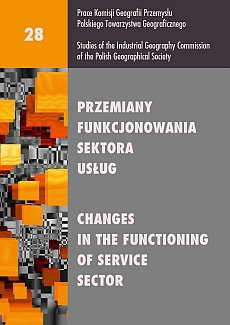Polityka lokalizacyjna wybranych systemów hotelowych na Kubie w zmieniających się realiach politycznych
DOI:
https://doi.org/10.24917/20801653.28.1Słowa kluczowe:
Kuba, polityka lokalizacyjna, systemy hotelowe, turystykaAbstrakt
Z każdym rokiem wzrasta znaczenie Kuby na międzynarodowym rynku usług turystycznych, co uwidacznia się w wielkości zagospodarowania turystycznego oraz liczbie turystów zagranicznych odwiedzających ten kraj. Kuba stosunkowo niedawno zaistniała jako obszar znaczącej recepcji turystycznej. Długotrwała izolacja tego kraju spowodowała, że od początku lat 90. XX wieku koniecznym było podjęcie szeregu działań zmierzających do poprawy zagospodarowania turystycznego, zarówno w aspekcie ilościowym, jak i jakościowym. W opracowaniu zostanie poddana analizie polityka lokalizacyjna wybranych sieci hotelowych, zarówno zagranicznych (Sol Melia), jak i kubańskich (Cubanacan, Gaviota). Jednym z podstawowych problemów badawczych będzie przedstawienie ekspansji przestrzennej hoteli poprzez pryzmat już istniejących regionów turystycznych, ich przyrodniczej i kulturowej specyfiki, a także regionów planowanych. Dodatkowym elementem będzie analiza uwarunkowań przyrodniczych, kulturowych, infrastrukturalnych (dostępność komunikacyjna), ekonomicznych i politycznych dalszych inwestycji systemów hotelowych. Wydaje się być zasadnym stwierdzenie, że najważniejszym czynnikiem decydującym o rynku turystycznym na Kubie, szczególnie w aspekcie historycznym, był czynnik polityczny, wynikający z chęci izolacji turystów zagranicznych od miejscowej ludności, a to spowodowało powstawanie enklaw turystycznych.Downloads
Metrics
Bibliografia
Brenner, L. (2005). State-planned tourism destinations: the case of Huatulco, Mexico. Tourism Geographies, vol. 7, 138–164.
Cervino, J., Cubillo, J.M. (2005). Hotel and tourism development in Cuba. Opportunities, management, challenges, and future trends. Cornell Hotel and Restaurant Administration Quarterly, 46(2), 223–246.
Derek, M. (2007). Od wioski rybackiej do turystycznej enklawy? Turystyka a rozwój lokalny na przykładzie Mikołajek. Studia Regionalne i Lokalne, 2(28), 112–127.
Durydiwka, M., Duda-Gromada, K. (2011). Między autentycznością a kreacją – tendencje i przyczyny zmian w przestrzeni turystycznej. Przestrzeń turystyczna. Czynniki, różnorodność, zmiany. Warszawa: Uniwersytet Warszawski, Wydział Geografii i Studiów Regionalnych, 53–63.
Jędrusik, M. (2005). Wyspy tropikalne. W poszukiwaniu dobrobytu. Warszawa: Wydawnictwa Uniwersytetu Warszawskiego.
Kauppila, P. (2010). Resorts and regional development at the local level: a framework for analysing internal and external factors. Nordia Geographical Publications, 39(1), 39–48.
Kowalczyk, A. (1999). Polityka lokalizacyjna wybranych systemów hotelowych. Turyzm, 9(1), Łódź: Uniwersytet Łódzki, 137–159.
Kowalczyk, A. (2001). Geografia hotelarstwa. Łódź: Wydawnictwo Uniwersytetu Łódzkiego.
Lau, G., McKercher, B.(2007). Understanding the Movement Patterns of Tourists in a Destination: A GIS Approach. Tourism and Hospitality Research, 7(1), 39–49.
Lew, A., Mc Kercher, B. (2006). Modeling tourist movement: a local destination analysis. Annals of Tourism Research, 33(2), 403–423.
Matthews, H.G. (1977). Radicals and third world tourism: A caribbean focus. Annals of Tourism Research, 5(1), 20–29.
McKercher, B., Lew A.A. (2004). Tourist flows and the spatial distribution of tourists. W: A.A. Lew, C.M. Hall, A.M. Williams (red.): A companion to tourism. Blackwell, Malden, Oxford and Carlton, 36–48.
Renata Rettinger Núñez, G.G., Fernández, R.O. (2011). Cuba y el turismo norteamericano. Analisis de potencialidades y de impactos en la región caribeña. Cuba Futures Series, 141–199.
Oppermann, M. (1995). A model for travel itineraries. Journal of Travel Research, 33, 57–61.
Pérez-López, J.F. (1995). Cuba’s Second Economy: From Behind the Scenes to Center Stage. New Brunswick, NJ: Transaction Books.
Pérez-López, J.F. (2001). Cuba’s Socialist Economy: the Mid-1990s. W: I.L. Horowitz, J. Suchlicki, (red.). Cuban Communism. 10. wyd. New Brunswick: Transaction Publishers, 205–236.
Sheller, M. (2004). Natural Hedonism: The Invention of Caribbean Islands as Tropical Playgrounds. W: S. Courtman (red.) Beyond the Blood, the Beach and the Banana: New Perspectives in Caribbean Studies. Kingston: Ian Randle.
Stewart, S.I., Vogt, C.A. (1997). Multi-destination trip patterns. Annals of Tourism Research, 24, 458–461.
Whittle D.J., Lindeman K.C., Tripp J.T.B. (2003). International Tourism and Protection of Cuba’s Coastal and Marine Environments. Tulane Environmental Law Journal, 16, 1–57.
Pobrania
Opublikowane
Jak cytować
Numer
Dział
Licencja
Artykuły publikowane są zgodnie z warunkami licencji Creative Commons (CC BY-ND 4.0; uznanie autorstwa-bez utworów zależnych).

